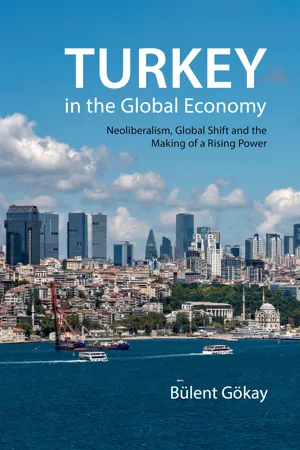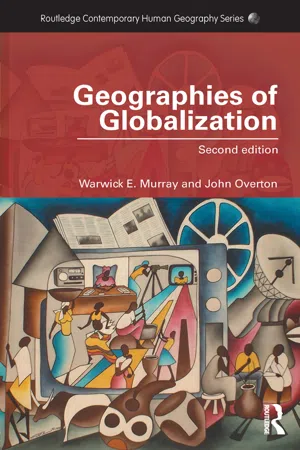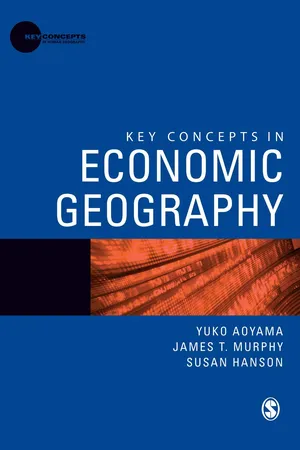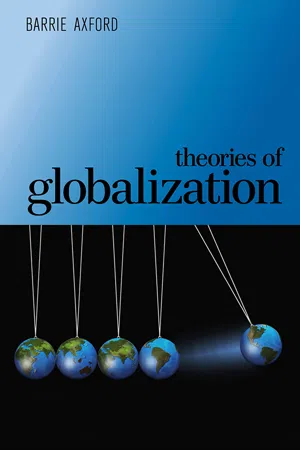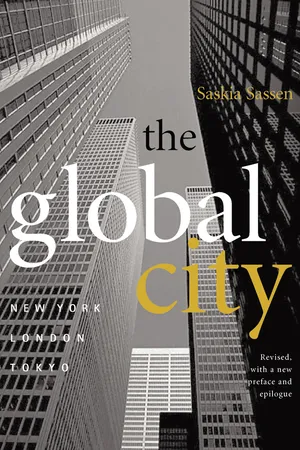Geography
Global Shift
"Global Shift" refers to the ongoing process of economic and industrial transformation, marked by the movement of manufacturing and service industries from developed to developing countries. This shift has significant implications for global trade, employment patterns, and the distribution of wealth and power. It is driven by factors such as technological advancements, changes in consumer demand, and the pursuit of cost efficiencies.
Written by Perlego with AI-assistance
Related key terms
5 Key excerpts on "Global Shift"
- eBook - ePub
Turkey in the Global Economy
Neoliberalism, Global Shift, and the Making of a Rising Power
- Bülent Gökay(Author)
- 2021(Publication Date)
- McGill-Queen's University Press(Publisher)
1.
An emerging market economy
“[O]ld geographies of production, distribution and consumption are continuously being disrupted and that new geographies are continuously being created. In that sense, the global economic map is always in a state of ‘becoming’; it is never finished. But the new does not simply obliterate the old. On the contrary, there are complex processes of path dependency at work. What already exists constitutes the preconditions on which the new develops.” – Peter Dicken (2007: 32)“We have had a couple of hundred bad years, but now we’re back.” – Clyde Prestowitz quotes a Chinese friend1The global political economy
During the period when the Turkish economy was being fully integrated into the world economy, the global system was experiencing one of its historic structural transformations when deep-seated movements and shifts of positions were affecting every single economy in the world. This is what soon came to be known as the Global Shift: a shift in the hegemonic structures of the world economy – a shift away from North America and Western Europe to the emerging economies of the Global South in Asia, Africa and South America. Drawing on comparative analyses, historians and political economists identify patterns and causes of hegemonic power decline, such as decreasing economic and technological resources relative to those of rising powers (Kennedy 1987; Grygiel 2006; Kupchan 2011). These studies inform contemporary theoretical debates on power transition from the powers in the Global North to the powers in the Global South, mainly based on the analyses of the economic rise of China, the growing assertiveness of Russia or the dynamism of India. - eBook - ePub
- Warwick Murray, John Overton(Authors)
- 2014(Publication Date)
- Routledge(Publisher)
The global economy has grown in complexity and breadth almost without interruption since the industrial revolution. As it has done so, it has been conditioned by and has conditioned economic geographies of change that have the power to fundamentally alter people’s lives for better or for worse in specific places in all four corners of the planet. This change has become bewilderingly rapid and intricate, simultaneously integrating and marginalising individuals and societies at increased velocity. In this chapter, we trace the evolution and nature of the globalising economy. We begin with a consideration of the crucial role of circuits of capital and spatial divisions of labour both of which underpin the historical evolution of the global economy and have conditioned the differentiated patterns we see today. Having considered the role of changing modes of regulation, we consider the pivotal influence of the contemporary transnational corporation. Finally, we discuss the increased tendency towards regionalization that we witness in the contemporary global economy. A number of key questions underlie our discussion here: What imperatives underlie the rapid expansion of the global economy? How do commodity chains and divisions of labour integrate economic activity? What are the implications of the growth of TNCs economically and politically? Does regionalism imply a move towards broader globalization or a move away from it? Is the global economy becoming more uneven or more homogeneous?New economic geography and spatial divisions of labour
Geographers have defined economic geography in many different ways, but it essentially refers to the spatiality of the economy. The most straightforward, and yet surprisingly rich, definition is offered by Roger Lee inThe Dictionary of Human Geography (2000a, p. 195) as ‘geographies of peoples’ struggle to make a living’. Stutz and De Souza (1998 , p. 41) offer another useful definition, seeing economic geography as ‘concerned with the spatial organisation and distribution of economic activity, the use of the world’s resources, and the distribution and expansion of the world economy’. In the 1990s there was something of a revolution in the sub-discipline. Critics charged that the old economic geography was economically deterministic; ahistorical; overly descriptive and quantitative; and incapable of dealing with moral and ethical questions (see Barnes, 2009 ; Bryson, 2012 ;Coe et al., 2009; Daniels and Jones, 2012 ; Peck and Yeung, 2003 ). Reflecting broader changes in human geography in general, and in particular the cultural turn - eBook - ePub
- Yuko Aoyama, James T Murphy, Susan Hanson(Authors)
- 2010(Publication Date)
- SAGE Publications Ltd(Publisher)
5.3 Institutions ).4.2 GLOBALIZATION
Economic globalization is being driven by the geographical dispersal of markets, the functional integration of production activities, and the increasing interconnections and interdependencies between people and places in the world economy. Since the 1980s, popular books about the concept have become commonplace and have generally taken views for (e.g. Friedman, 2005) or against (e.g. Stiglitz, 2002) its contemporary dynamics, meanings and consequences. In academia, analyses of globalization have come from a variety of disciplines including: economics (e.g. Bhagwati, 2004), political science (e.g. Held and McGrew, 2007), sociology (e.g. Sklar, 2002) and cultural studies (e.g. Appadurai, 1996). Economic geographers have demonstrated how circumstances at the local scale, and the spatial connections linking economies, play key roles in determining how places and regions influence and are influenced by globalization (e.g. Kelly, 1999; Bridge, 2002; Dicken, 2004). Because the breadth of the concept is so extensive, some of these contributions are addressed in other chapters of this book (e.g. 1.1 Labour ; 6.3 Consumption ; 6.1 Knowledge Economy ; 6.2 Financialization ). Emphasis in this chapter is placed on three themes central to the economic geographies of globalization: the role of multinational corporations (MNCs) in globalization and the New International Division of Labour (NIDL); why there are limits to economic globalization; and how globalization has forced geographers to rethink their conceptualizations of spatial scale.Multinational corporations and the new international division of labour
As the global economic crisis of the mid-1970s persisted, scholars began observing significant changes in the location of industries and the strategies and structure of large corporations. Hymer (1976) and Fröbel et al. (1978) argued that MNCs were reorganizing the world economy in new ways that differed from the classical (i.e. Ricardian) division of labour; that is, a situation where a country’s comparative advantage in trade was based simply upon whether it was a raw material supplier or a producer of manufacturing goods. In this new age of global capitalism, a New International Division of Labour (NIDL) was emerging as manufacturing activities shifted from advanced industrial economies into the developing world. Central to this transformation was MNCs’ use of multi-country input sourcing strategies that distributed production across many places and significantly increased the cost-efficiency of manufacturing systems. This spatial reorganization of production was made possible in part by logistics innovations (e.g. containerization) and information technologies (IT) and by changes in the structure of the world financial system (Taylor and Thrift, 1982; Castells, 1996). - eBook - ePub
- Barrie Axford(Author)
- 2014(Publication Date)
- Polity(Publisher)
Spatial change is part and parcel of globalization, but the narrative of change occurring through time is also central to how globalization is theorized, or should be, even allowing for different conceptualizations of time (Adam, 1994; Urry, 2003). The problem lies in how such theorization integrates or fails to integrate these discourses. Most accounts approach globalization as a temporal phenomenon through its relationship with modernity, while those with a stronger spatial inflection explore the relationships between bounded nation-states and borderless capitalism. In the former there is no single treatment of the provenance of globalization, which is variously taken to pre-date modernity (Frank, 1998; Therborn, 2000; Gills and Thompson, 2006), intensify modernity (Giddens, 1990; Scholte, 2005a) or transcend modernity (Albrow, 1996; Hardt and Negri, 2000; see also Robertson, 1992; Sassen, 2006). Accounts with a stronger spatial inflection sometimes treat space as constitutive of the social, and focus on the playing out of two generally acknowledged dynamics of globalization: changes to the nation-state and changes in the scale of social processes. Corbridge and Agnew (1995) and Kuus and Agnew (2008) suggest that purely spatial narratives of globalization de-historicize space and the nation-state, reducing the latter to a static, essentialized concept not a million miles from the realist model - eBook - ePub
The Global City
New York, London, Tokyo
- Saskia Sassen(Author)
- 2013(Publication Date)
- Princeton University Press(Publisher)
Part One THE GEOGRAPHY AND COMPOSITION OF GLOBALIZATIONA LEADING ARGUMENT in this book is that the spatial dispersion of economic activities and the reorganization of the financial industry are two processes that have contributed to new forms of centralization insofar as they have occurred under conditions of continued concentration in ownership or control. The spatial dispersion of economic activity has brought about an expansion in central functions and in the growing stratum of specialized firms servicing such functions. Reorganization in the financial industry has been characterized by sharp growth, rapid production of innovations, and a proliferation of financial firms. These conditions, I argue, shifted the point of gravity in the industry away from the large, mostly American, transnational banks that had once dominated the industry toward major centers of finance.The fact that telecommunications and information technologies are essential to both processes has added yet another force for agglomeration. Finance and specialized services are major users of such technologies and need access to the most advanced facilities. These technologies, which make possible long distance management and servicing and instantaneous money transfers, require complex physical facilities, which are highly immobile. Such facilities demand major investments in fixed capital and continuous incorporation of innovations. A second and, I will argue, crucial factor giving global cities an advantage is the organizational complexity they contain which allows firms to maximize the benefits they can derive from the new technologies.International transactions have expanded the scale and raised the complexity of these processes. However, the spatial and organizational logic at work is also evident at the national level. Whether internationalization is essential to the major outcomes, notably the acute pressure, toward agglomeration in leading cities, is difficult to establish and is perhaps a question of theory. But the requirements that global production arrangements and markets bring about are a key factor in the organization of major industries and in the significance of specialized services for firms.
Index pages curate the most relevant extracts from our library of academic textbooks. They’ve been created using an in-house natural language model (NLM), each adding context and meaning to key research topics.
